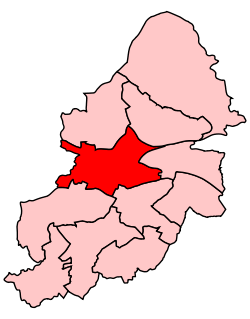Ladywood
| Ladywood | |
 Ladywood | |
| Population | 14,801 (2001 Population Census) |
|---|---|
| - Density | 27.0 per ha |
| OS grid reference | SP055865 |
| Metropolitan borough | Birmingham |
| Metropolitan county | West Midlands |
| Region | West Midlands |
| Country | England |
| Sovereign state | United Kingdom |
| Post town | BIRMINGHAM |
| Postcode district | B1-B4 |
| Dialling code | 0121 |
| Police | West Midlands |
| Fire | West Midlands |
| Ambulance | West Midlands |
| EU Parliament | West Midlands |
| UK Parliament | Birmingham Ladywood |
| |

Ladywood is an inner-city area in Birmingham, England. It is a council constituency, managed by its own district committee. The constituency includes the smaller Ladywood ward and the wards of Aston, Nechells and Soho.[1] In June 2004, Birmingham City Council conducted a city-wide "Ward Boundary Revision" to round-up the thirty-nine Birmingham wards to forty. As a result of this, Ladywood's boundaries were expanded to include Birmingham city centre.[2][3]
Demographics
At the time of the 2001 Population Census, 23,789 people were living in Ladywood. The population density was 3,330 people per km² living within its 7.1 km² boundary, compared with 3,649 people per km² for Birmingham. Nearly half of the population of Ladywood (49%) consists of ethnic minorities compared with 29.6% for Birmingham in general. The largest ethnic minority groups are Afro-Caribbean at 13.18%, Indian at 11.65%, Pakistani at 10.64% and Mixed Race at 5.52%.[4][5]
Housing and land use

The Ladywood ward combines areas of varying land-use, such that no generalisation is possible. There is the city centre (the economically valuable Central business district), the affluent Jewellery Quarter, and Broad Street areas which have become fashionable for "luxury flat" living, the Lee Bank area (now known as Park Central) which has been fully redeveloped, and there is the remainder of the ward (herein: "remainder Ladywood") which is relatively economically impoverished.
Most of "remainder Ladywood" (and area now occupied by Park Central) was redeveloped during the 1960s, with decaying terraced slums being cleared to make way for new low-rise housing and high-rise flats. Although the newer homes were an improvement on their predecessors in terms of quality and sanitation, social problems became prevalent in much of the local area including car crime, drug dealing, anti-social behaviour and many of the other problems commonly associated with inner city areas across England.
More than 20 multi-storey blocks of council flats were built around Ladywood during the 1960s and 1970s; however, six of them were demolished in the early 2000s.[6]
More recently there has been investment in physical improvements to the area. Some tower blocks have been either demolished or improved, not least with introduction of concierge or CCTV security systems. These and other such measures may have resulted in a reduction of antisocial behaviour.
There are plans to build high-density housing, possibly over 1,100 units, on 54 acres of derelict industrial land at Icknield Port. The proposals include old-style back-to-backs with internal courtyards raising fears of future slums[7]
The area is served by two libraries; Spring Hill Library[8] and Ladywood Library.[9]
Politics
The ward is currently represented by three Labour councillors at the Birmingham City Council; Sir Albert Bore, Kath Hartley and Carl Rice.[10]
Ladywood Ward has adopted a "Committee Manager" and an "Interim Neighbourhood Manager". These are Kay Thomas and Sandra Lawrence respectively.[11]
Unemployment
In July 2010, it was reported that the Parliamentary Constituency of Ladywood had the highest rate of unemployment out of all the constituencies in the United Kingdom with 10.8% claiming Jobseeker's Allowance. It was further reported that Ladywood had the highest rate in the UK for at least the previous 61 months (statistics produced on a month by month basis).[12][13] This may be blamed on the recession, but very high unemployment rates have been a problem in Ladywood for a number of years.[14]
Famous residents
- Washington Irving (1783–1859). A famous American writer. Inspired to write whilst living with family in Birmingham.[15]
- Alfred Joseph Knight (1888–1960). World War I Victoria Cross recipient.[16]
- J.R.R. Tolkien (1892–1973) A famous writer, known best for The Lord of the Rings (lived in an area of Edgbaston now taken over by the extension of the Ladywood Ward boundaries).[17]
See also
- St. John's Church, Ladywood
References
- ↑ "Ladywood Community Plan".
- ↑ "Ladywood Ward". Birmingham City Council (Economy Strategy and Information Team).
- ↑ "Roll Forward to 40 Wards". Birmingham City Council. 2004-09-27.
- ↑ "Office for National Statistics – Ethnic Group Table". Neighbourhood.statistics.gov.uk. Retrieved 2012-02-28.
- ↑ "Ladywood Ward Stats". Birmingham City Council. Retrieved 2010-01-07.
- ↑
- ↑ "Councillor Fears Slums of the Future At Icknield Port Loop". Brumnews.co.uk. Retrieved 2012-02-28.
- ↑ "Spring Hill Library". Birmingham City Council.
- ↑ "Ladywood Library". Birmingham City Council.
- ↑ "Ladywood Councillors". GB-BIR: Birmingham.gov.uk. 2009-08-26. Retrieved 2012-02-28.
- ↑ "Ward Committees". Birmingham City Council. Retrieved 2010-01-07.
- ↑ "Recession Tracker". BBC NEWS c/o Office for National Statistics. 2010-04-21. Retrieved 2010-05-07.
- ↑ Rogers, Simon (2010-07-14). "Ten things to learn from the latest unemployment statistics: Unemployment is down overall, but up in Northern Ireland, Birmingham and among 16-year-olds. Here are the facts behind the latest joblessness headlines". The Guardian (London). Retrieved 2010-07-14.
- ↑ McSmith, Andy (2002-10-20). "Ladywood is UK dole capital". The Independent (London). Retrieved 2010-05-07.
- ↑ "Ladywood Ward". Birmingham City Council.
- ↑ "Sgt. Alfred Joseph Knight". Findagrave.com. Retrieved 2012-02-28.
- ↑ "Tolkien's youth in Birmingham". Birmingham City Council. Retrieved 2010-01-07.
External links
- Birmingham City Council: Ladywood Constituency
- Birmingham City Council: Ladywood Ward
- Ladywood Community Network pages
- Digital Ladywood – On-line local history project
- Park Central Development – Ladywood
| ||||||||||||||||||||||||||||||||||||||

